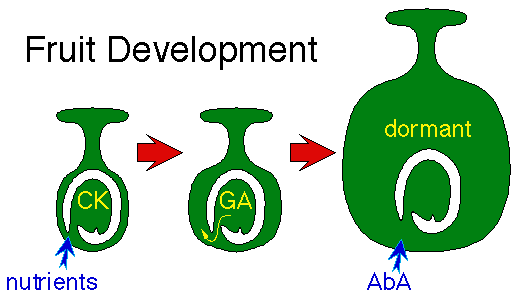
The seeds developing inside the ovary wall produce hormones. At first they produce cytokinins which are hormones that are exported from the seed and cause cell division in the ovary wall. This, of course, adds some thickness to the wall of the growing fruit. Next, the developing seeds produce gibberellic acid which is exported to the wall of the ovary and causes rapid expansion of each of the cells. The combination of more cells and expanding cells leads to tremendous increase in the size of the ovary. As this is happening, the mother plant is producing another hormone, abscisic acid, which causes the embryo in the developing seeds to become dormant. This is adaptive because it prevents the seed from sprouting inside the warm, moist fruit.
This sequence of events is diagrammed below. Please note: in fruits that lack seeds, we can apply a solution of gibberellic acid and get some full-sized fruits in spite of no seeds to make gibberellic acid. A good example of that is in Thompson seedless grapes...every green seedless grape in the grocery was treated about three times in the growing season with a dilute solution of gibberellic acid to make it grow to normal size. Without these treatments the fruits would be small, spherical, and likely to fall off of the cluster before the fruits could get to market.

Once we have a full-sized fruit, there are three different ways to categorize them. Of course, as we think about growth of a full-sized fruit, we remember it came from a flower. It is appropriate to consider fruit types based upon their floral origins.
In some cases one flower develops into just one fruit. This is because that one flower contained just one pistil that matured into a simple fruit. Examples of simple fruits are cherries, apples, and tomatoes. The pistil might be simple or compound, but because each flower makes just one fruit, we have a simple origin.
In other species, one flower develops into several fruits in a cluster. This happens because that one flower contained several pistils...probably unfused simple pistils...that each became a fruit. We call this an aggregate fruit because one flower gave rise to many fruits. Examples of aggregate fruits include raspberries and strawberries.
In yet other species, a whole cluster of flowers--an inflorescence--gets pollinated and fruits develop. However as these several fruits grow, they merge and fuse into a single fruit body. Because many flowers produce fruits that fuse into just one single body, we call this a multiple fruit. Examples of multiple fruits include figs, mulberries, and pineapple.
Another way to categorize fruits is to classify them on the basis of what parts of the flower contribute to the overall fruit. Here there are just two categories.
A true fruit is one that consists of nothing but ovary wall. There are no other contributions to the fruit body. A good exams is cherry and peach. Here, after pollination, all the other parts of the flower fall off of the pedicel. Even the style and stigma abscise, leaving just an ovary. The ovary wall thickens. The outer layers of ovary become fleshy and red, the inner layers become hard and stony. They surround a single seed. This is a true fruit because it is ovary wall plus contents...nothing more.
An accessory fruit is one that has more than ovary wall as part of the fruit body. Other parts of the flower swell along with the expanding ovary wall. Frequently the receptacle participates. Ovaries that are inferior or that are in perigynous flowers often have accessory tissues surrounding or subtending the true fruit. A good example of an accessory fruit is a watermelon. The true fruit is red at maturity, the accessory is white. Another example is apple. The cartilaginous core is the true fruit, the white tissue you like to eat is the accessory. Yet another example is strawberry. The true fruit is a dry achene, the accessory is red and juicy at maturity.
Perhaps the most "human" way to categorize fruits, however, is by how they appear to us. This is a descriptive method. The first separation is to decide whether the mature fruit is fleshy (juicy) or dry (stony, papery, woody, etc.).
Fleshy fruits can be of several different descriptions, but three major categories come to mind right away: drupes, berries, and pomes.
The drupe is a fleshy fruit that has a stony inner layer surrounding (usually) a single seed. This fruit has a pit. Examples include cherry, coffee, and peach. In some examples, coconut and almond come to mind, we often sell just the pit in the store as people prefer to eat the seed rather than the fleshy layers of the fruit.
A berry is a fleshy fruit that has no stony layer in the fruit, but contains one to many seeds. Good examples of classic berries include grape and tomato.
The berries that develop in citrus flowers have exceedingly oily surface layers over a pithy subtending layer. The specialized berry in citrus are known as a hesperidium. Examples include lemon, lime, orange, and grapefruit. In these, the compound pistil forms the fruit and the individual "sections" are the ovaries of the carpels that are fused into that one pistil.
Other specialized berries develop from flowers with inferior ovaries. These will, of course, have accessory layers contributed by the surrounding receptacle and other tissues. A very large group of well-known examples include watermelon, cucumber, pumpkin, and squash. In these plants the specialized berry is called a pepo. In watermelon we enjoy eating the true fruit. For pumpkin, cucumber, and squash humans generally prefer the accessory rind rather than the slimy true fruit.
Dry fruits can be divided into two separate groups: dehiscent and indehiscent. Dehiscent dry fruits are those that open on their own to shed seeds into the environment or onto an animal for dispersal. Indehiscent dry fruits do not naturally open to shed seeds; rather they disperse their fruits into the environment or attach them to an animal for dispersal. Of course these contain the seeds...
The dehiscent dry fruits come in several types depending upon how they open up to shed seeds. The follicle develops from a single carpel and therefore has seed(s) in one locule. The mature dry carpel splits naturally along one side to release the seeds. Example follicles include the fruits of magnolia and milkweed.
The legume also develops from a single carpel with one locule, but it differs by splitting along both sides of the fruit to shed its seeds. Legumes are typically found in the huge bean family. Examples include green bean, navy bean, pea, redbud, honey locust, and black locust. The legumes are incredibly numerous and important members of tropical rain forest ecosystems.
The silique is similar to a legume in splitting along two sides, but, because there are two carpels making up the pistil, there is a wall between the two fused locules that remains attached to the receptacle after the fruit opens. This septum can be interestingly dry and silvery, as in the "silver dollar plant" or "money plant." Its genus name Lunaria reminds us that the septum looks like a silvery full moon. The silique is found in most members of the cabbage family.
The capsule develops from many carpels that fuse together as a compound pistil. Their many locules open separately to shed their seeds. Thus the capsule of a poppy has one pore on the parietal wall that opens to shed seeds from each of several carpels that make up the capsule. In a certain way the poppy fruit resembles a salt-shaker. The immature opium poppy capsule is wounded to bleed latex that is collected as raw opium. An alcohol tincture of raw opium, called paregoric, is an old medicine that is very effective against diarrhea. The active ingredient is morphine. Another ingredient in the latex is codeine...very effective at suppressing cough. Humans have modeled dextromethorphan after codeine, and heroin is a semisynthetic derivative of morphine.
Indehiscent dry fruits fail to open in any way and are shed as a fruit for dispersal.
The achene is a small, one-seeded fruit. The fruit is separate from the seed coat, so the seed is contained in a defined locule. An example achene is strawberry. Strawberry? Yes, a strawberry fruit is not technically a berry, it is not even a fleshy fruit! The red part you enjoy eating is a fleshy accessory to a dry fruit. The true fruit is the tiny dry fruit on the surface of the strawberry. You can tell it is the ovary because you can find complete carpels on the strawberry if it has not been to vigorously scrubbed. The style and stigma is a tiny hair-like appendage extending from the ovary. The ovary is yellow when immature and brown at maturity. The achene passes through the digestive system of a bird, weakening the fruit wall. This way, when the fruit is delivered to soil, along with some fertilizer, the seed inside can sprout!
Another small, one-seeded fruit is the caryopsis or grain. The difference between the achene and the caryopsis is that during development in the grain, the seed coat fuses to the fruit wall, so it gives the appearance of the fruit lacking a locule! The grain is the most important fruit for human nutrition...examples include: rice, wheat, corn, oats, and barley.
Even dry fruits can come from an inferior ovary and therefore have accessory tissue. The cypsela is a small, one-seeded dry fruit that has an accessory layer on its fruit because the ovary was inferior in the flower. Examples include members of the daisy family. Sunflower "seeds" sold commercially are often actually sunflower fruits. You have to remove the accessory and true fruit husk to get to the actual seed. True sunflower seeds are often served in a container at a salad bar...sans husks.
Some small one-seeded dry indehiscent fruits develop a larger wing-like outgrowth. This kind of fruit is called a samara and ash, elm, and maple trees have samaras. The samara of the maple develops as one of a pair which are partially fused together. Because the maple fruit splits into two halves before shedding, it is also known as a schizocarp.
Last on our list of dry, indehiscent fruits is the nut. This fruit has a leathery ovary wall that can be quite hard at full maturity. It is surrounded partially or completely by layers of bracts (leafy appendages) for form an involucre around the base of the fruit. The "cap" of an acorn is the involucre. The acorn itself is the nut. Another good example is the filbert (hazelnut). Please notice that "fruit and nut" is a redundant expression because a nut is a fruit! Also please note that not everything that people call "nuts" are botanically nuts. The coconut is sold as a pit from a drupe. The peanut is the seed from a legume. The almond is the seed from the pit of a drupe. So when the advertisement says: "Sometimes you feel like a nut, sometimes you don't" please remember than neither candy bar has nuts in it!
Now, just to bring these three different classification schemes together a bit, let us consider three examples:
The raspberry comes from just one flower, but each tiny part of a raspberry is a drupe with contained pit developing from its own carpel. The tiny hairs projecting from each drupe is the corresponding style and stigma. So the origin of the raspberry is aggregate, the composition is true, and the description is fleshy, drupe.
The apple comes from just one flower, but it has five carpels in its pistil that form the cartilaginous core. It is surrounded by fleshy receptacle tissue. So the origin of the apple is simple, its composition is accessory, and its description is fleshy pome.
The mulberry forms from a short stalk of flowers, each flower producing one fruitlet, that fuse together to form one mulberry. So the mulberry is a multiple, true, fleshy drupe.
The cocklebur tells us the story of George de Mestral. This man was hiking in the French part of the Swiss Alps. He was wearing some woven wool pants and got many cockleburs clinging to the slacks. You might notice that the surface extensions on the cocklebur have tiny hooks (French: crozier) which were attaching to the thread-loops (velvet) of his pants. He noticed how tenaciously that croziers attached to the velvet. His entrepreneurial mind led him to figure out a way to produce an attachment system based upon velvet and synthetic croziers. This product, of course is vel-cro! His keen observations and creative mind led him into a powerful financial position! Maybe Botany can inspire you too!
When talking about beans, the fruit is the pod that opens like a pencil wallet, while the seeds are the part we eat. But it is not always so easy to distinguish the fruit from the seed.
There are four main fruit types.
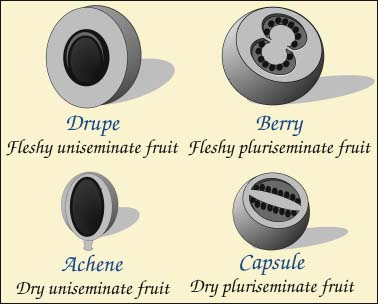
Apricot and kiwi are examples of fleshy fruits. Their flesh is sweet and juicy, designed to be eaten by animals or men. Plants slowly elaborate this flesh, concentrating solar energy in sugars. While eating fruits, animals are working for plants. They are performing seeds dispersal. Apricot contains only one seed (uniseminate), well protected in its hard stone: it is a drupe. Kiwi contains many tiny seeds (pluriseminate): it is a berry.


There are two kinds of dry fruits. Some have a unique seed, others have many.
Those which enclose only one seed don't open up. They are called achene. Dry fruit's walls are usually ornated with architectures which have a very important function in preservating and dispersing its seeds. Like most of the plants of the Compositae family, thistles bear achenes which are topped by an egret. These small parachutes will carry away in the air their valuable load of life.


For cereals, each grain is called caryopse. The fruit wall is fused together with the seed coat. Everybody knows corn. Big yellow grains are well and tightly ordered in their ear. Nowadays corn is one of the major cereal cultivated world-wide together with rice and wheat.
To make things simpler, achenes and caryopses are usually called "seeds".
Dry fruits containing many seeds open up and release them far and wide. They are called "dehiscent" fruits. There are many kinds of dehiscent fruits: capsules, siliquas, follicles,... Let's look at two examples:
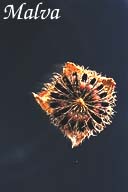
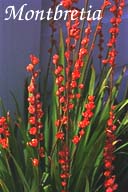
This malva has a tiny dry fruit (1 cm diameter), composed of open cells radiating around a central axis, a Malvacae family feature. Among the seventeen small rouge seeds, four already escaped in the picture below. Are they gone far away?
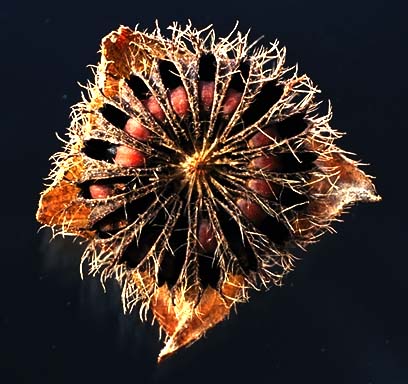
Along the stalks of this montbretia, capsules open up three cells containing bright orange seeds. Like an open cup, they are waiting to be spread by the wind, or more surely by some gardener (it is a cultivated species).